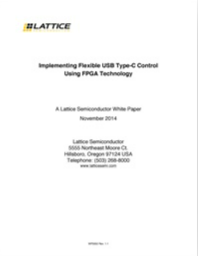Implementing Flexible USB Type-C Control Using FPGA Technology
Type-C interfaces bring dramatic benefits to consumers. However, in order to realize this potential designers must implement Type-C's Power Delivery (PD) protocol, detect cable orientation and switch high speed signals, as needed and, if desired, provide support for Vendor Defined Messaging (VDM).
This whitepaper will show you how low-cost FPGA devices can be used in combination with off-the-shelf USB devices to develop products which take full advantage of the interface's speed, power and versatility, and how they can be brought to market in a rapid manner.
Download this whitepaper to find out more.
Read More
By submitting this form you agree to Lattice Semiconductor Corporation contacting you with marketing-related emails or by telephone. You may unsubscribe at any time. Lattice Semiconductor Corporation web sites and communications are subject to their Privacy Notice.
By requesting this resource you agree to our terms of use. All data is protected by our Privacy Notice. If you have any further questions please email dataprotection@techpublishhub.com
Related Categories: Analog, Communication, Embedded, Power, Processors, Resistors, Switches

More resources from Lattice Semiconductor Corporation
Embedded Signal Processing Capabilities of the LatticeECP3 sysDSP Block
New market segments are increasingly driving competing FPGA vendors to incorporate a wider variety of functionality and flexibility within their de...
USING LOW COST, NON-VOLATILE PLDS IN SYSTEM APPLICATIONS
System designers are faced with continual pressure to meet their development schedules, and need to implement designs with minimal effort and risk ...
Intellegently Expanding Microprocessor Connectivity Using Low-cost FPGAs
Whether they be CPUs, micromicroprocessors or microcontrollers, microprocessors are an indispensable component in modern electronic system design. ...
